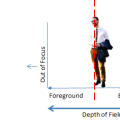The center of interest in a frame is the key element and everything around it should work to showcase it. The foreground, especially when it occupies a significant portion of the frame can be a distraction if the photographer is not paying due attention to it.
So follow these 4 tips for better foreground in photographs and learn what a difference well composed foreground can make in your pictures.
Empty foreground – Too much of empty foreground should be avoided. Either move in or try to include something to balance the empty area. The Norris Basin on Yellowstone National Park offers many photo opportunities, although visitors have to be confined on well defined tracks. The couple of logs are something interesting in an otherwise empty foreground.
Wide angle frame – You need to pay special attention to the frame while using wide angle lens, since you could be having quite a bit of foreground. You need to think of that space in relation to the rest of the picture. You will create a successful composition if you can effectively utilize the space. While on the scenic drive at the Capitol Reef National Park, I liked the distant cliff against the thunderclouds and found a small flowering shrub to fill the foreground.
Lead into the picture – Use the foreground to lead into the frame. Lines or curves can be effectively used to do this. But it can be more subtle, like an arrangement of objects. The spotless white tablecloths of Soho restaurant caught my attention but the early spring afternoon was still a bit too chilly for pavement diners. I was waiting for someone to complete the composition and then the lady came out of the store with her purchase. If you are shooting against the light, you can use shadows to make the foreground more interesting as in the picture at the Washington Square Park.
Distracting foreground – While out of focus background is desirable in many cases, out of focus foregrounds are distractions most of the time. Remember that foreground depth of field is less than background depth of field. If you do have out of focus foreground, see if the impact of the picture changes by cropping out the out of focus region. There are some exceptions such as in macro photography when the foreground is so out of focus that it creates a pleasing blur. An blob of color that does not relate to the rest of the picture is another cause for problem in the foreground. Pay attention to the viewfinder and exclude any distraction from the frame.





